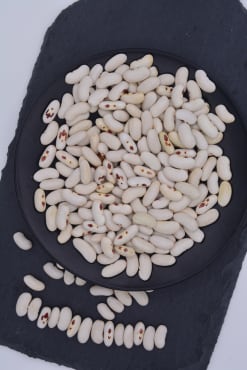(88 days) Open-pollinated. When about a plant’s-worth of white seeds turned up in 20 lb of Carol Deppe’s golden Gaucho beans, she picked them out and planted them. The resulting plants looked identical to Gaucho, and again the beans were the same size and shape as Gauchos but white with a candle pattern on the hila. A recessive mutation present in Carol’s Gaucho population must have become homozygous in one plant. What fun! White Candle Gauchos have a milder flavor and the same high yield and agronomic characteristics as Gaucho. The two beans can be planted in the same row—occasional crosses between sister varieties aren’t a big deal. Save seeds from plants at the ends of the row and eat the ones that mingle toward the middle! By developing sister lines such as these, Carol is building ease of seed-saving right into the varieties’ genetics. OSSI. Breeder Royalties. ①
White Candle Gaucho Shell & Dry Bean - Organic
White Candle Gaucho Shell & Dry Bean - Organic
(88 days) Open-pollinated. When about a plant’s-worth of white seeds turned up in 20 lb of Carol Deppe’s golden Gaucho beans, she picked them out and planted them. The resulting plants looked identical to Gaucho, and again the beans were the same size and shape as Gauchos but white with a candle pattern on the hila. A recessive mutation present in Carol’s Gaucho population must have become homozygous in one plant. What fun! White Candle Gauchos have a milder flavor and the same high yield and agronomic characteristics as Gaucho. The two beans can be planted in the same row—occasional crosses between sister varieties aren’t a big deal. Save seeds from plants at the ends of the row and eat the ones that mingle toward the middle! By developing sister lines such as these, Carol is building ease of seed-saving right into the varieties’ genetics. OSSI. Breeder Royalties. ①
Additional Information
Shell and Dry Beans
- Average 130 seeds/2oz packet. 2 oz packet sows 25 ft; 1 lb, 200 ft. All bush beans except where noted.
- Days to maturity are from emergence after direct sowing.
Culture: In conditions of high nitrogen fertility some bush beans may develop vines in moist hot weather. Tender, will not survive frost. Plant 3–4 seeds/ft in rows 24–30" apart. Pick frequently for maximum yields, but avoid disturbing foliage in wet weather to prevent spread of fungal diseases.
Harvest at shelling stage when beans are plump inside pods. For dry beans let pods dry hard on the vine until pressing the beans with your fingernail leaves no indentation. If heavy rains or hard frost threaten before full dry maturity, either pull plants by the roots and hang them in a dry place to finish; or pick pods into mesh or paper bags and finish drying them indoors before threshing.
Beans
- All beans are open-pollinated.
- Days to maturity are from emergence after direct sowing.
Culture: Tender, will not survive frost. Inoculate with a legume inoculant, then plant seeds 3–4" apart in rows 24–30" apart after all danger of frost has passed and soil has warmed. Minimum germination soil temperature 60°; optimal range 70–80°. White-seeded beans are generally more sensitive to cold soil temps than dark-seeded varieties. Legumes have moderate fertility needs and can fix their own nitrogen. Excessive nitrogen may induce some bush varieties to develop vines in moist hot weather.
Saving Seed: Saving bean seed is easy! Leave pods on the plants to dry. Hand shell, or stomp pods on a tarp. To ensure true-to-type seed, separate varieties by 30 feet.
Diseases:
- ANTH: Anthracnose
- BBS: Bacterial Brown Spot
- CBMV: Common Bean Mosaic Virus
- CTV: Curly Top Virus
- DM: Downy Mildew
- HB: Halo Blight
- NY 15: NY 15 Mosaic Virus
- PM: Powdery Mildew
- PMV: Pod Mottle Virus
- R: Rust
- SC: Sclerotina
White mold, Sclerotinia sclerotiorum, affects more than 300 plant species. In beans, low humidity, good air circulation and wider spacing, both between plants and between rows, reduce the likelihood of this soil-borne infection.
Germination Testing
For the latest results of our germination tests, please see the germination page.
Our Seeds are Non-GMO

All of our seeds are non-GMO, and free of neonicotinoids and fungicides. Fedco is one of the original companies to sign the Safe Seed Pledge.





